HO Racing History
Tribute Site |
|
|
|
The
origins of HO scale slot car racing can be traced to England, where in
the late 1950's the English inventor, Derek Brand first developed a
small motorized car to be used with model railroads. |
|
|
|
|
|
|

|
|
|
| Aurora Model Motoring |
|
The
American model company, Aurora Plastics Corporation first saw the
Playcraft Model Motoring system on display at an English toy fair and
promptly acquired the marketing rights to the Model Motoring product
line for sale in the U.S. Market. |

|
|
|

|
|
|
|
|
|
|
| Aurora ThunderJets |
|
In
1963 Aurora introduced the Thunderjet 500 chassis in response to
customers' complaints about the difficulties they had keeping the
original Vibrator cars running well. The Thunderjet 500 chassis, or just
T-Jet, was designed so that the original Vibrator bodies could continue
to be used with this new, faster and more maintainable chassis. |
|
|
|
|

|
|
|

|
|
|

|
|
|
|
|
| Boy's Life Grand Prix Raceway |
|
|
|
|
|
|
|
|
|
|
| Aurora Factory Experimental - A/FX |
|
Aurora
was quick to follow with a larger 1:64 scale chassis design of their
own called the Aurora Factory Experimental or A/FX for short. The larger
chassis made it possible for Aurora to produce bodies that were just as
detailed as their competitor, Tyco's offerings. |
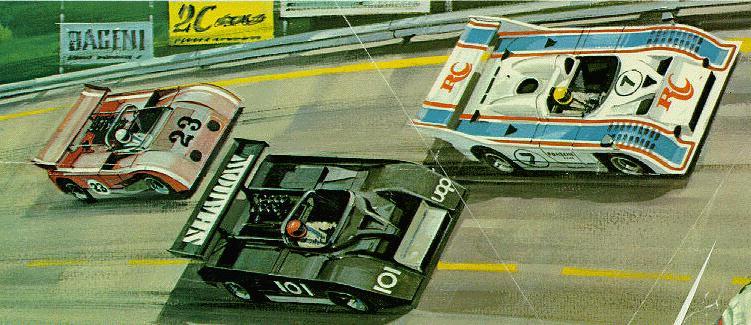
|
|
|

|
|
|
| Aurora A/FX Magna-Traction |
|
The
A/FX chassis, with its larger and more powerful motor magnets made it
evident that if the magnets could be placed low enough in the chassis
they would be attracted to the metal power rails in the track and allow
the cars to stay in the slot better in the turns. |
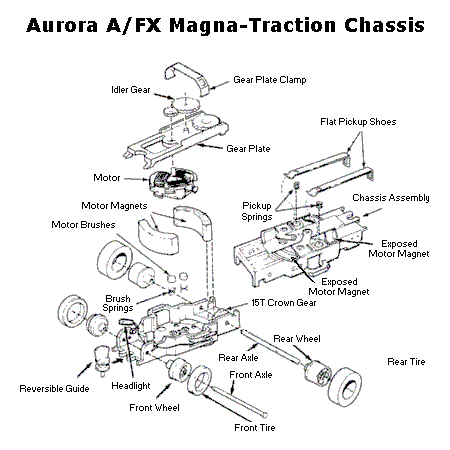
|
|
|
| Aurora G+Plus |
|
Aurora
realized that in order to compete against the more powerful Tyco
chassis they would have to design a new chassis that abandoned the
pancake-style motor in favor of one that used the same simplified
horizontally mounted motor arrangement that had made Tyco slot cars so
successful. |
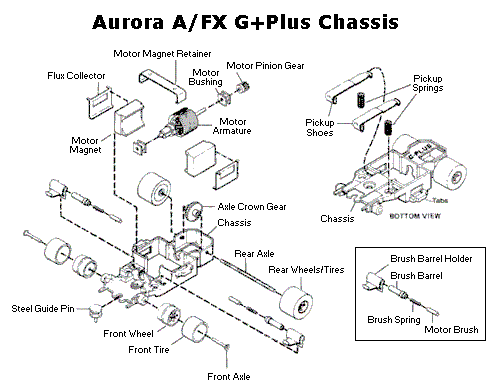
|
|
|
| The Lean Years |
|
The
early 1970's brought about a drastic decline in interest for slot cars.
Many of the original slot car racers that had made Aurora so successful
throughout the 1960's were now getting older. As they graduated from
High School and went off to college their HO slot car sets were moved to
the attic, or sold at garage sales. |
| ...More to Come... |
|
|

|
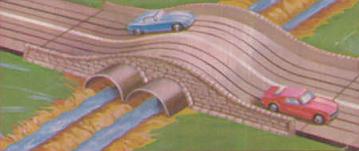 A 2-lane track
system was also designed for these early model cars to run on. The first
track system was marketed in England by Playcraft under the brand name
Electric Highways Model Motoring.
A 2-lane track
system was also designed for these early model cars to run on. The first
track system was marketed in England by Playcraft under the brand name
Electric Highways Model Motoring. The very first
boxed sets were powered by small AC power packs, or directly from the
accessory circuit on transformers used to power model trains.
The very first
boxed sets were powered by small AC power packs, or directly from the
accessory circuit on transformers used to power model trains.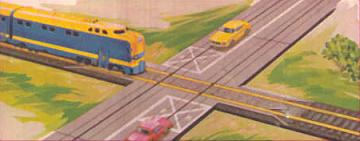 Most American
model railroad sets sold in the early 1960's where made by Lionel.
Lionel trains were 'O' gauge, or 1:48 scale. The 'HO' scale was just
beginning to gain in popularity. It was exactly half the size of the
then popular 'O' gauge sets. The term HO actually means Half-'O' gauge
or 1:87 scale.
Most American
model railroad sets sold in the early 1960's where made by Lionel.
Lionel trains were 'O' gauge, or 1:48 scale. The 'HO' scale was just
beginning to gain in popularity. It was exactly half the size of the
then popular 'O' gauge sets. The term HO actually means Half-'O' gauge
or 1:87 scale. A Corvette
String Ray and Jaguar XKE sportscar were added to the line, along with a
front-engined Indianapolis racer and a rear-engined Grand Prix style F1
car.
A Corvette
String Ray and Jaguar XKE sportscar were added to the line, along with a
front-engined Indianapolis racer and a rear-engined Grand Prix style F1
car.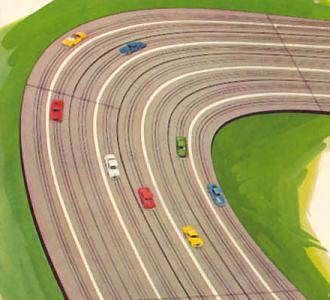 Aurora's early
success with HO slot car racing made it possible for them to expend the
financial resources required to develop new and exciting products. A
full line of track sections was added, making it possible to build large
HO raceways with up to 8 lanes. New body styles were constantly being
added to the line. In 1966 alone Aurora added several more race cars to
their already impressive line-up. A Ford GT-40, Cobra GT Coupe, Porsche
904, Chaparral, Lola GT, Ferrari Dino and Ford MK-IV were all added to
their catalog.
Aurora's early
success with HO slot car racing made it possible for them to expend the
financial resources required to develop new and exciting products. A
full line of track sections was added, making it possible to build large
HO raceways with up to 8 lanes. New body styles were constantly being
added to the line. In 1966 alone Aurora added several more race cars to
their already impressive line-up. A Ford GT-40, Cobra GT Coupe, Porsche
904, Chaparral, Lola GT, Ferrari Dino and Ford MK-IV were all added to
their catalog.

 Tyco's larger
1:64 scale chassis made it possible for them to offer cars with more
realistic proportions and better details, not to mention being much
easier to repair. The Tyco chassis also provided wide rear hubs and soft
racing slicks that dramatically improved handling over the skinny
ThunderJet rear tires.
Tyco's larger
1:64 scale chassis made it possible for them to offer cars with more
realistic proportions and better details, not to mention being much
easier to repair. The Tyco chassis also provided wide rear hubs and soft
racing slicks that dramatically improved handling over the skinny
ThunderJet rear tires.